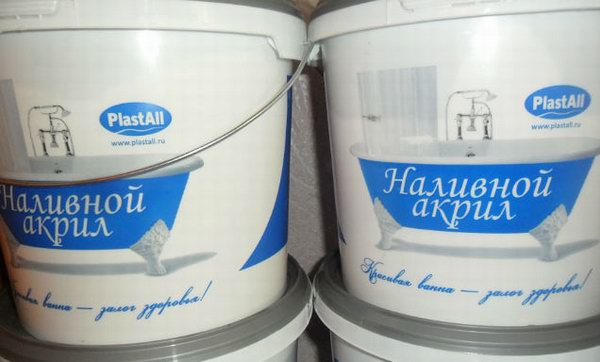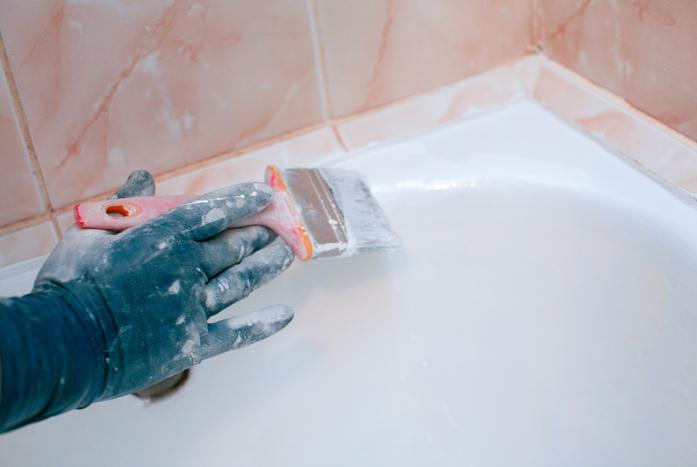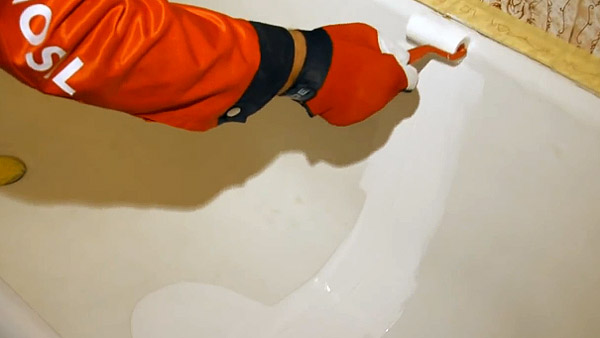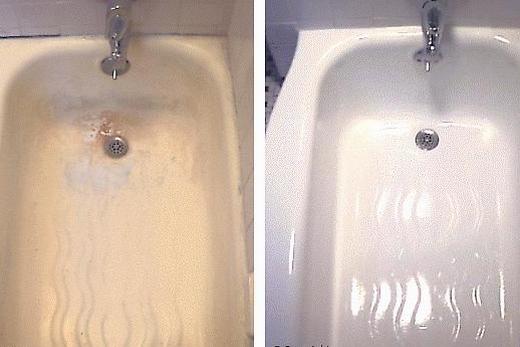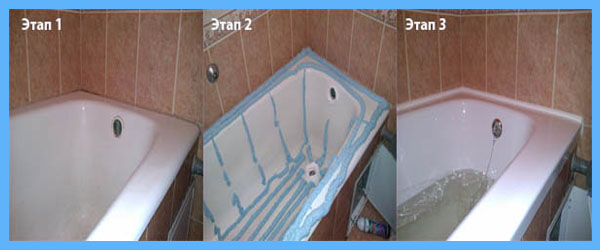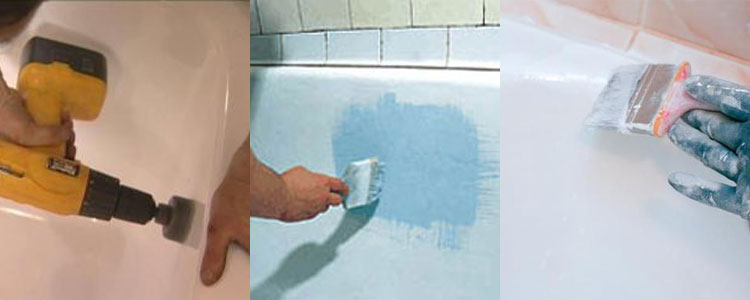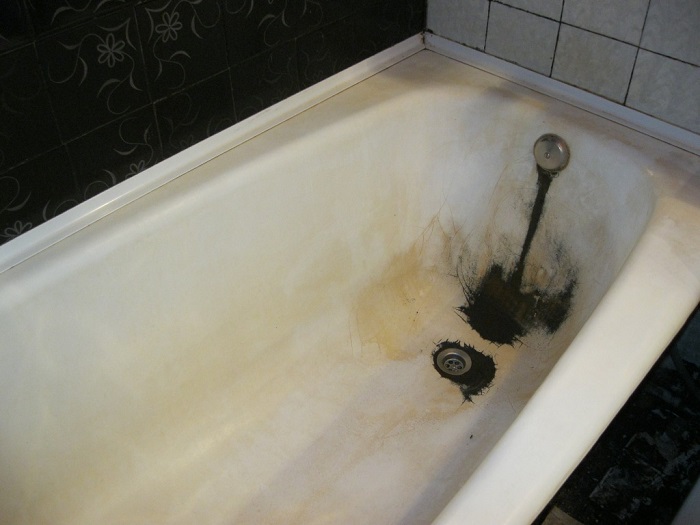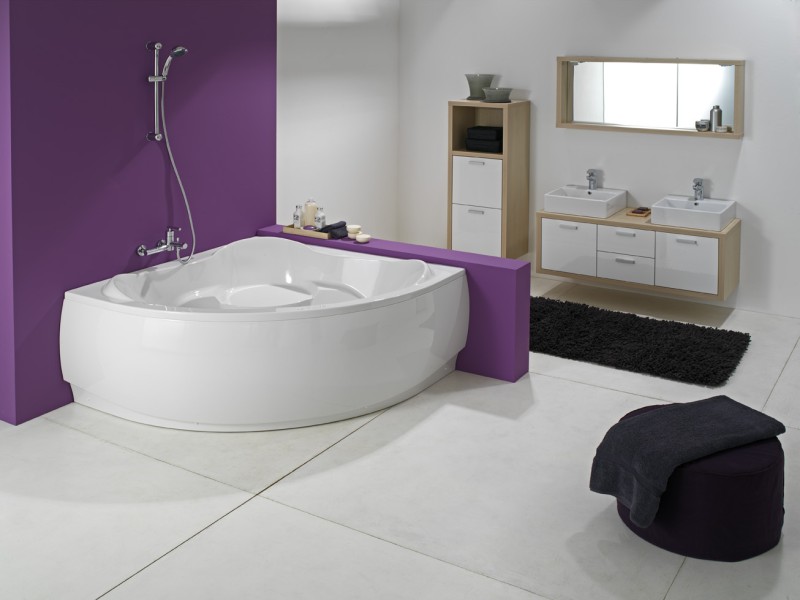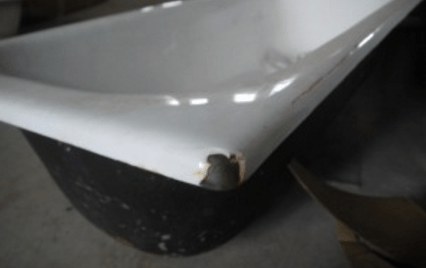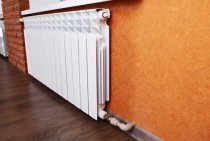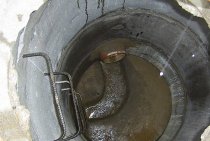Types of enamels for painting
This method is classic and successfully used for budgetary restoration of the enamel coating of bathtubs. There are two types of enamels: professional and regular. The first is used by specialists with extensive experience in enamelling. This is due to the fact that the composition of the mixture has a high fluidity and in order to apply a layer of a certain thickness, it will be necessary to paint in several layers. At each stage, a layer of the same thickness is created without streaks and streaks. With experience, it is possible to perform partial restoration of the old coating with high accuracy. Ordinary enamel is thicker and the entire coating is painted at a time, but with minor errors.
Coating
Cast iron bath restoration
Over the years, the cast iron bath begins to fade and crack. This is no reason to replace it. It can be restored by hand. Enamel restoration and polishing is a process available to everyone. It does not require large financial costs and does not take much time. The main thing in this business is desire and patience.
The update process includes the following steps:
- cleaning of the entire internal surface;
- primer;
- applying a new layer of enamel.
Surface cleaning begins with the removal of rust and dirt. To do this, use the cleaning powder "Pemolux" or oxalic acid. The agent is applied to the places where rust appears for 30-40 minutes, after which it is washed off with water. If it is not completely removed, then rub the stain with fine sandpaper. The tub is rinsed and dries naturally.
https://youtube.com/watch?v=UU1EyfwpkFM
After washing and drying, a layer of aerosol primer from a can is applied to the inner surface of the bath. The bottle is shaken vigorously several times beforehand. The applied primer coat should dry well.
The final stage is the application of enamel. It comes in aerosol cans and cans. It is better to use nitro enamel in a jar. It is applied when the humidity in the bathroom is not more than 60%. Otherwise, the enamel may spread. To apply enamel, a flat brush with natural bristles is used.
You need to apply a double layer. Each must dry for at least 40 minutes. The last layer of enamel is recommended to be moistened with a solvent. This will help create a beautiful glossy film. The enamel should dry for at least a day. After complete drying, the inner surface of the bathtub is polished with a special paste applied to a soft flannel cloth.
You can use enamel not only in the traditional white color. The purchase of a primer and enamel of any color is much cheaper than a new one. Caring for an updated cast-iron bathroom is desirable with products that do not contain chlorine and acids. It is better to use dishwashing detergents. It is recommended to clean the bowl only with a soft sponge. Do not allow bleach to come into contact with the enamel surface.
Steel bathtubs are not subject to such restoration. They are not used very often, as they cool quickly. Cast iron and acrylic bowls in the bathroom are quite durable. Enamel coating restoration is available to every owner. All you need is a little patience, accuracy and following the instructions for restoring the enamel layer.
Compositions for a bulk bath
A "bulk bath" can be made using two types of products - glass and liquid acrylic. They are different from each other, and a common mistake for beginners is to mistake them for the same substance.
Stakryl began to be used about 10-15 years ago. It is relatively inexpensive and has a fairly high strength. After applying it to the bath, it should be dried for at least 4 days - and already here you can see a clear difference between the substance and ordinary liquid acrylic, which has shorter drying times.
Stakryl is also afraid of mechanical damage, so it is important to handle the bathtub covered with it carefully and carefully.

Liquid acrylic, on the other hand, has recently appeared on the building products market. It has higher strength and resistance to various mechanical influences. The coating made from it retains a glossy sheen for a long period of time. By the way, the smell from it is much less sharp than from glass. Acrylic dries in just 36 hours.
In general, both materials can be used for the restoration of bathtubs and other plumbing. But you should definitely know the difference between them.
Summing up what has been said, it can be noted with confidence that it is quite possible for everyone to restore the bath with their own hands, restore its former grandeur and neat appearance without the use of drastic measures to replace the bath itself. But the service life of such updated products (or rather, their coatings), of course, is not so great.
















Acrylic bath liner - installation steps

Hot tub - before and after
During the operation of a cast-iron bath, due to certain circumstances, damage to the enamel may occur due to mechanical impact and, as a result, the formation of rust spots. The appearance of the bath becomes unaesthetic and the owner faces several ways to solve this problem, one of which is a do-it-yourself restoration.
Preparing the surface for restoring the enamel of the bath
First you need to very carefully remove the old enamel from the bath, remove all chips and scratches. Using scouring powder and sandpaper, clean the surface of the tub. Do not rush into this work, because how long the new layer of enamel will last depends on its quality.
The resulting mixture is washed off with water, and the bath is examined again so that there are no small pieces of enamel left. To be completely sure, you should clean it again. Then the cleaned bath must be rinsed very well and degreased, and then dried. The dried surface is examined again. If there are large chips, you can take a special glue and level the surface of the bath with it, which should become smooth and dry.
Priming of the surface of the restored bathtub
The next step in the restoration of bath enamel is the surface primer. Now the building materials market offers products for priming various surfaces. You can use an aerosol primer, working with it will not cause much trouble, and you can easily prime the surface of your bath.
You can take a special mixture to restore the surface. In any case, when choosing a primer, you need to read the instructions for use and choose the appropriate option depending on the properties of the enamel that will cover the bath.
Priming must be done with high quality so that there are no smudges and bubbles, which during operation can cause exfoliation of the new layer. The bathtub must be completely dry when finished.
Applying a new layer of enamel to the bath
The final and especially important stage in the restoration of the bathtub enamel is the application of a new layer of enamel. This is done with a brush with natural hair, you can make a soft swab from a piece of cloth. Many people prefer a tampon, because after applying with a brush, hairs can remain that will ruin the look of a new bath. Enamel is applied in several layers, and each layer is thoroughly dried. Do not forget to first study the instructions supplied with the enamel, given by the manufacturer.
The enamel layer will become absolutely solid in five to six hours, but for this the air temperature must be at least twenty degrees. But it is recommended to use the bath after applying all layers only after a week. At the factory, enameling is carried out in a special way, which means it is much stronger, but with proper operation and good care, your bathtub will last a long time.
It should be noted that to restore the enamel of the bath, it is much faster and more convenient to use enamel in an aerosol package, but such a coating will serve much less than enamel from a jar.
And finally, a few tips for use:
- do not use cleaning powders and solutions containing acid to wash the bath;
- do not soak laundry in the bath, especially with bleach.
By following all the tips and recommendations when using a bathtub with restored enamel, you will extend its service life, which will give you great pleasure.
New Tips:
- Order of metal-plastic windows and their installation
- Installing a hot tub - the main stages and subtleties of connection
- What mounting plumbing modules are
- How to choose the right range hood for your kitchen
- Hot water column - which one to choose for a country house
Previous Tips:
- Types of toilets - which toilet is better to choose
- Installation and dismantling of the kitchen sink yourself
- How to install a bidet yourself
- Siphon installation independently and its types
- Installing a bathtub - tips from an experienced plumber
Next tip >>
How to restore an acrylic bath
Restoration of an acrylic bathtub is one of the most common everyday everyday problems, since even the most modern and high-quality acrylic bathtub is subject to wear, mechanical damage during operation and corrosion.
So how do you get your bathroom back to its original shine and newness? Let's take a look at this question.
How to restore the acrylic coating of the bath?
Restoring a bathroom with liquid acrylic should proceed on its own, subject to the following instructions:
Before applying liquid acrylic to the surface of the bath, it is necessary to clean it from the top layer of rust (if any) and grind the surface of the bath with a drill with a grinding nozzle or sandpaper
When grinding, special care must be taken.
It is necessary to wash off the top layer of dirt left from the bathroom grinding.
It is required to degrease the surface of the acrylic bathtub with soda or a special solvent.
In the event that there are cracks or chips, it is necessary to putty the surface of the acrylic bath in place of these defects.
To apply liquid acrylic, you first need to warm the surface of the bath with hot water, since acrylic lies only on a warm surface.
The top and bottom drains are dismantled, or sealed so that the acrylic does not enter the sewer. Substitute special dishes.
Start restoration with liquid acrylic.
If done right, your bathtub will look perfect and feel like your acrylic bathtub is brand new.
How to polish an acrylic bath?
Acrylic bathtubs are becoming increasingly popular. They are elegant, easy to fit into the interior and unpretentious in care, so even if minor defects in the form of scratches appear on the surface of acrylic baths, they are very easy to restore and polish, so that the appearance will return and your acrylic bath will be like new.
In order to polish your acrylic bathroom, you need to stock up on the following: wax polish, vinegar or lemon juice, chrome spray, detergent, silver polish, toothpaste.
To polish the surface of your acrylic bathtub, follow these instructions:
If the acrylic bathtub is not heavily soiled, then it is necessary to apply a detergent or cleaning agent with a sponge on its surface and leave for 10 minutes.
In this case, the top layer of dirt will be removed, but if there are traces of heavy dirt on the surface, then silver polish is indispensable.
Traces of scale are removed with acetic or citric acid.In the event that scratches appear on the walls of the bath, it is necessary to wipe the bath in the places of the defect with an emery cloth, and then apply a layer of abrasive gel to this place, wipe the damaged area and wipe it dry.
After that, you need to apply a wax polish, wipe the surface and leave for a few minutes. If your acrylic bath has a layer of chrome fittings, then you need to wipe the bath with an aerosol and leave for 5 minutes, then rinse with a stream of cold water.
How to paint an acrylic bath?
Probably, everyone faced in his life with the problem of repair, restoration and painting of the bathroom. It is worth remembering that, first of all, the issue of painting and restoration should arise in the absence of a desire to dismantle or replace the bathroom.
The bathroom should be replaced if there are holes, chips and cracks on its body, and if the appearance has deteriorated over time, but there are no mechanical damages, the bathroom can simply be painted. Special techniques are used when painting acrylic bathtubs.
Then, with a special construction gun, acrylic paint for restoration is applied, which can be bought at any major hardware store, and after the surface has dried, a special paste is applied.
It is applied to give a shiny effect and give the acrylic bathtub an updated, refurbished look.
In no case should an acrylic bathtub be painted with other chemical compounds using a roller or brush. In this case, the top layer will peel off, or over time, all the paint will fall off the surface.
DIY bath polishing tips on how to make the bath smooth
If the bath has begun to resemble emery, it is unlikely that water procedures will give you pleasure. In this case, you may need to polish the bath with your own hands.
First, let's figure out why this problem appears at all. It's not just about the quality of the water, but also about the choice of detergents. Strong chemicals corrode the enamel. Various chips also negatively affect, for example, from a fallen soul or other heavy objects.
Tip: It is worth carefully studying the tips and recommendations for the operation of the bath. For example, they often say that it is better not to use a bath for washing animals, as fingernail scratches remain on the enamel. Also, do not wash your shoes directly in the bathroom. To remove dirt from the enameled surface, in no case should you use a brush and strong detergents. Soap solution and a soft sponge are ideal.
Today we will talk about how to make a bath smooth. If it is too late to save the bath, and there is no way to replace it, you can polish the bath with your own hands.
The polishing technology for all types of bathtubs is different, so let's go in order. Is it possible to remove the roughness of a steel bath at home? No. This is the only exception.
Therefore, steel baths mostly have negative reviews from repair masters. For all other material types there is an alternative.
Acrylic bathtubs
Acrylic bath polishing
In order to polish an acrylic bath, you need to prepare everything you need in advance. You will need a mild detergent, vinegar, chrome spray, sandpaper, abrasive polish, toothpaste, sponge and wax polish.
- To begin with, toothpaste removes various stains from the enamel. Lemon juice helps to get rid of traces of scale.
- After there are no stains left, you can start removing scratches with sandpaper.
- Then the bathroom is polished, and only at the last stage we use wax polishing. It is best applied with a soft cloth.
- Polishing is completed by washing it with a mild soapy solution and a sponge. Chrome parts are treated with a special aerosol. Then the bath is rinsed with water.
Hydromassage bath
Hot tub polish
- In order to polish the hot tub, it must be rinsed well.The best solution is to fill it with soapy water and turn on the hydromassage function for at least five minutes.
- After that, it is better not to drain the water for another 15 minutes. Repeat the steps with plain water to wash off the soapy residue.
- The polishing itself takes place in the same way as with a simple acrylic bath, but takes more time. For restoration, you will have to remove a small layer of enamel about two tenths of a millimeter.
Cast iron bathtubs
Applying enamel to a cast iron bath
With a cast-iron bath, things are somewhat more complicated. Polishing occurs according to the following scheme: cleaning the surface, priming, applying a new layer of enamel.
Rust can be removed with an ordinary powder cleaner, which must be applied for at least half an hour.
After the bath has been washed and dried, you can proceed to the primer. It is better to use an aerosol can. Now again you have to wait until the surface of the bath dries.
Finally, you can proceed to the application of enamel. The most popular is nitro enamel in banks. For its application, it is better to use a flat brush made of natural bristles.
Please note that when using it, the humidity in the room should not exceed 60%.
Enameling is applied in two layers, each of which takes about an hour to dry. For the effect of a glossy shine, the last layer is wetted with a solvent
Then the bath is left for a day, and only after it is completely dry, they begin to polish with paste.
The advantage of self-priming and enameling is a varied choice of colors. After all the work, it will feel like a new bath. Only such pleasure is much cheaper.
Important: Please note that the new enamel is not as reliable as the factory one. It is better to refrain from using strong detergents and never use bleach in the bathroom.
Conclusion
The pleasure of a new smooth bath, no matter how good quality it is, will not last long. Hard, chlorinated water in modern apartments spoils any coating and natural operating costs over time. If the enamel in the bathroom has become rough, use our tips.
Loading…
Recommended reading:
Acrylic bath polishing
The easiest way to polish acrylic is to use a flame. As a result of this procedure, internal stresses will arise in the plastic, which will need to be removed somehow. Therefore, it is absolutely not worth polishing an acrylic bathtub with a flame. She just crumbles. So let's look at other options.
Gloss on plastic can be restored very easily with the help of special polishing pastes. With visible scratches, stains from chemicals and cigarette butts, you will have to tinker more. It will be necessary first to grind with abrasive means, to grind off a layer of acrylic to a depth no less than the deepest scratch. In practice, you have to rip off the plastic a little more.
It may not sound paradoxical, but grinding and polishing a bathtub are, in principle, one and the same. In both cases, the surface of the material being processed is scratched, but to a different depth with a gradual decrease in it.
Polishing an acrylic bath begins with a very fine abrasive, the so-called zero sanding. Then continue with polishing pastes with varying degrees of grit and finish without abrasive.
The whole question as acrylic
The vast majority of bathtubs and shower trays sold in Ukraine, in Europe and America would not even be allowed to enter the store.
Products made of laminated plastic (ABS plastic) that come into contact with the skin are prohibited there.
Usually in ABS/PMMA on shower trays the acrylic layer is 5% of the total thickness of the combined plastic, on bathtubs 10%. Considering that the minimum thickness of this plastic on such products can reach 0.2 mm. (twenty hundredths of a millimeter), then one can easily understand the insignificance of the thickness of the actual acrylic layer.
Scratches and stains from chemical and thermal damage on co-extruded plastic are best not touched at all. Even the most gentle sanding will expose the rubber-based plastic. If it is white, then it will very soon become brownish, and if it is greenish, then you will immediately be horrified by what you have done.
How to choose the grain size of the polishing paper?
Sinks, shower trays and bathtubs made of acrylic can be sanded and polished. Depending on the depth of damage, you need to choose the roughness of the sanding paper.
If you try to smooth out large scratches over large areas with very fine sandpaper, you can end up wasting a lot of time. On a semi-matt surface, damage is clearly visible. When the acrylic is matted with a fine sandpaper, it will seem that all the scratches have disappeared. That this is not so will be revealed only when polishing when the shine begins to appear.
We'll have to start again with grinding. When acrylic is hard enough, more or less refractory, you can try to use a power tool at the smallest speed for work.
A plastic bath is not an iron car hood that removes heat. Acrylic can instantly float, melt.
A decent acrylic manufacturer recommends operating with short-term heating no higher than 75-80 ° C. Then it will deform. It's really good plastic.
There are many brands of acrylic used for the manufacture of sanitary ware with much worse properties. This is especially true for shower trays. Even the most expensive brands do not hesitate to use not the highest quality continuous casting acrylic for their manufacture.
small cracks in acrylic
Can I polish small cracks in the bottom of the tub? Definitely not! If there are cracks, then on real acrylic they go to the entire thickness of the plastic. Yes, the crack is microscopic, and let's grind it to the reinforcing layer.
On combined plastic, it sometimes happens that only the acrylic film will crack. Cracks can then of course be removed, but again together with all the acrylic.
Before you start restoring an acrylic bathtub, sink, pallet, it is advisable to understand their quality, how and what they are made of. This is not a restoration of an old cast-iron bath, where even the most monstrous defect in the work can be somehow corrected.
Advantages and disadvantages of bulk coating
Acrylic coating has high strength and therefore is able to protect the bathtub from external mechanical influences and significantly increase the service life. The method of its application is quite simple and even in the absence of experience in carrying out such work, difficulties will not arise. The coating is even and thick enough, due to the ability to fill in irregularities and minor surface defects. When applied, there are no pungent odors and therefore it is not necessary to use protective respiratory equipment. However, the drying time can be at least three days. Restoring an old cast-iron bath in this way will be very expensive.
Bath detergents
The easiest and most common way is to use special tools that clean the bathroom. The main thing for the right choice is to carefully read the product presented on the package so that there are no prohibited substances in the composition. Safe home remedies are also good.
- Detergent.
- Lemon acid.
- Vinegar.
- Soda.
- Toothpaste.
Citric acid solution
This type of cleaning is very popular and economical. Since this material perfectly cleans plaque, fats and other contaminants. The main thing to remember is that citric acid in its pure form is not suitable for acrylic, therefore, for its practical use, you need to prepare a solution. Fill the bathroom with warm water, then pour half a liter of acid, mix and leave overnight.
Apple vinegar
Cleaning these materials is very effective, but it does not always have a positive effect on the material itself. Work with vinegar should be quick and accurate.

Soda
It is the best helper in cleaning not only the bathroom, but the whole house. Only baking soda should be used with acrylic as it is less alkaline. The main thing is to use only diluted soda so as not to damage the body of the bath.
Toothpaste
Since the material acrylic came to the general consumer through dentistry, it is quite natural that this material can also be cleaned with toothpaste.
It is important to use only non-abrasive toothpaste for application.

Using any of these methods, you can clean acrylic from any strong and not strong pollution, and your clean and sparkling bath will delight you for a very long time.
Polishing instructions
Enamel bath stains will disappear if rubbed with toothpaste.
- The bath should be cleaned with a sponge dipped in water with a small amount of detergent added. It is not recommended to use products with abrasive components, formaldehydes (formic acid), ammonia, washing powder. Such detergents may dull its surface.
- Detergent is evenly applied to the surface of the bath for 10 minutes. After this time, the surface is wiped with a damp sponge and rinsed with water. If the contamination is quite strong, then the procedure will have to be repeated.
- Wax polishing is applied to the walls and bottom of the bath and gently rubbed with a soft cloth.
- Stubborn stains can be removed from enamel with detergents, toothpaste or silver polish. A small amount of any of these products should be applied to a soft cloth and rub the stain.
- Scale stains are removed with lemon juice or vinegar.
- The aerosol is sprayed onto chrome parts and washed off with a stream of water, then wiped dry.
- To remove small scratches from the enamel, the acrylic bath is washed, the scratch is processed with sandpaper, then an abrasive polish is used, and lastly, a wax polish.
Hydromassage bath
To keep the hot tub clean, it is recommended to carry out a general cleaning once a week.
To polish your hot tub:
- Fill the bathtub with warm water with detergent dissolved in it. Run the hydromassage system for 5 minutes. After turning off, leave the water in the bowl for another 10 minutes. After that, drain the water.
- Once again fill the bowl with clean water and turn on the hydromassage for 5 minutes to rinse the bath. Drain the water and continue polishing in the previously described order.
The entire work on updating the enamel will take about 3 hours, and the result will last for 10 years. During the polishing process, a layer of acrylic with a thickness of about 0.2 mm is removed from the surface. This will practically not affect the strength, since the bath has a thickness of 7 mm.
Full or partial restoration of enamel
This issue is considered in each case individually, since it is necessary to take into account the condition of the enamel, the service life and the amount of damage. If small chips were received during the delivery or installation of a new bathtub, then local treatment can be performed. But even in this case, there may be problems with the selection of color tone and the creation of a certain thickness of the coating. That is, traces of recovery will be, albeit a little, but noticeable. Once the rust spots are removed, the contrast will be more pronounced as the enamel has taken on a yellowish tint. Therefore, under the conditions of taking quick measures to preserve the metal, it is possible to perform partial processing and finishing, but to obtain the quality of the coating, a complete restoration is done.
How to remove tough stubborn stains
The rules for caring for plumbing must be learned when buying it, since different materials have their own characteristics and requirements. Each bath material must be cleaned in a different way:
- Acrylic products that are now common require only special cleaning products. Acrylic cannot be cleaned with abrasive and caustic agents, and some models of bathtubs do not tolerate chlorine-containing substances. Such acrylic care products are quite expensive and this is their main drawback.
- Some household chemicals contain mild cleaning agents that are difficult to remove rust stains and limescale. To remove such stains, special products are required. They can be used on a wide variety of surfaces.
- Aggressive products for removing stubborn stains and dirt. They can remove absolutely all types of dirt, but they negatively affect the enamel of the bath and can damage it with regular use.

Myth busting what to believe when renovating a bathroom
Often, many people postpone repairs or prefer to buy a new bathtub due to fairly common myths. They also become the cause of poor-quality repairs, causing quite a few problems when using plumbing. The most characteristic of them:
It is not necessary to process the surface of the bath manually, you can use a special sprayer.
- The surface can only be processed manually. This false statement simply stops many people: do-it-yourself sandpapering of a large bathroom until all the enamel comes off is very tiring. Decades ago they probably did, but today, with so many tools, it just doesn't make sense. Using special nozzles on the drill, the grinder can quickly and relatively easily completely prepare the surface for repair.
- Enamels for work are very harmful. This is far from the case; special food-grade enamel is used for painting, which is absolutely safe for humans. There is only one condition: after the repair is completed, it is advisable to bathe in five to seven days, not earlier, although polymerization occurs within three days.
- The paint layer must be very thick, so the repair is too costly and unprofitable. This is far from the case, it is necessary to apply paint on the surface in a thin layer, otherwise leaks will appear.
- New enamel or acrylic won't last long if applied by hand. In fact, a properly repaired bathtub will serve for decades, provided that the rules for caring for it are followed. If your old plumbing is in excellent condition, it's often better to just recoat it than to buy a new one.
- The most comical myth, according to the masters, is that enamel or acrylic simply does not stay on the surface of cast iron when applied on its own, after a year the coating begins to bubble. If you properly repair the bath, then the coating on it will last for decades, it will not crack, not to mention bubbles.
When is it time to refurbish your bath?
A cast-iron bathtub is a standard of quality, strength, and reliability in the plumbing world. No wonder it is advised to install products from this alloy in apartments. In many houses built back in the Soviet Union, just such bathtubs were installed. And such baths are used to this day. Also, a cast-iron product is comfortable to use: it does not create noise, unlike, for example, a thin-walled iron bath. Yes, and it is pleasant to wash in it - the bath retains the heat of the water poured into it much longer than others.

Unfortunately, even seemingly eternal things eventually wear out. And a cast-iron bath is no exception. At the same time, it is not she who deteriorates, but the coating - enamel, with which the structure was covered at the factory. And now this special paint, applied using a special technology, begins to lose its appearance, and its performance is deteriorating.

Here are some signs that it's time to upgrade your bathtub.
-
Roughness of the inner surface
. It is much more pleasant to step on smooth enamel than on a pumice stone resembling the touch. -
Bath cleaning is getting harder
. The reason is the very rough surface on which an ordinary sponge no longer slides easily and pleasantly. Cleaning a bathtub takes a lot of effort. -
Dirt and rust quickly and strongly eat into the enamel due to the loss of smoothness.
. In some cases, contamination cannot be removed at all. -
The appearance of chips and cracks
on the enamel surface.

It is these signs that inform the owner of the bath that it is time for her to “rest”.But do not rush to dismantle it and throw it away - the bath can be reanimated! And for this, there are three fairly simple and, moreover, relatively inexpensive ways - this is the use of an acrylic liner, the “filling bath” technique and enamel renewal.

